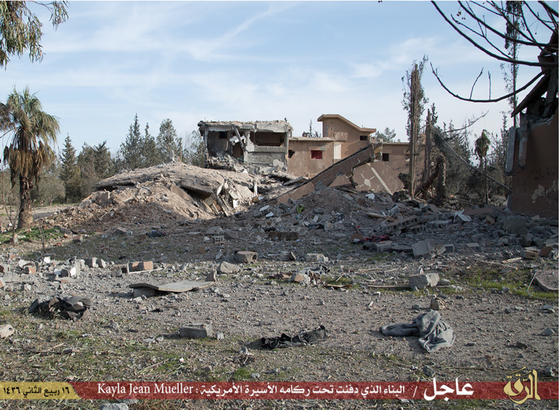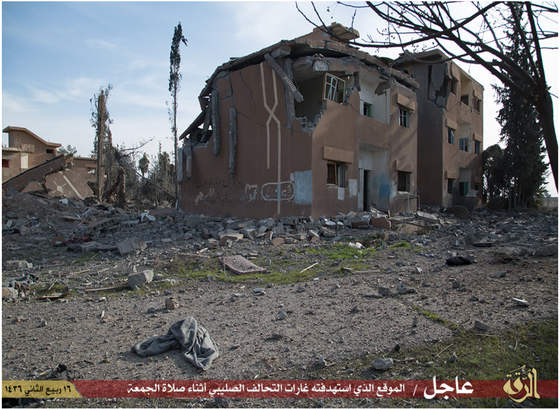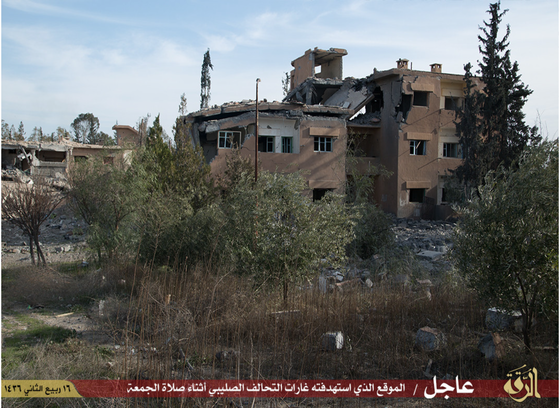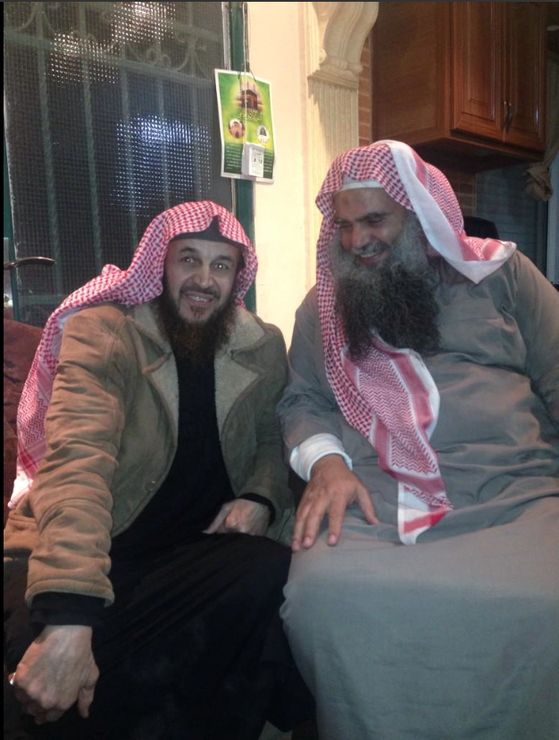The Long War Journal (Site-Wide) |
- Analysis: The Islamic State claims Jordanian airstrikes killed an American hostage
- Jihadists continue to advertise training camps in Iraq and Syria
- Al Qaeda jihadists celebrate release of anti-Islamic State ideologue
|
Posted: 06 Feb 2015 12:48 PM PST
Note: This article has been
updated to note that Foreign Policy has confirmed the US-led coalition
launched airstrikes in Raqqa earlier today.
A statement attributed to the
Islamic State claims that an American woman who was being held hostage, Kayla
Jean Mueller, was killed during Jordanian airstrikes earlier today. The
statement contains a photo set showing a building that was allegedly struck by
Jordanian bombers.
The claim could not be
independently verified and its overall veracity is questionable.
One photo published by the group
can be seen above and others at the end of this article. The web page
containing the announcement also purports to publish Mueller's address in
Arizona, her telephone number and email address.
Several elements of the statement
and the photos immediately draw into question the claimed circumstances
surrounding Mueller's alleged death.
The Islamic State set off an international controversy when its fighters burned a Jordanian pilot alive. Conveniently, the group now claims that Jordan's bombers killed an American hostage. It is not clear how the Islamic State knows the bombers that supposedly hit this area were Jordanian, as opposed to other coalition aircraft.
Moreover, the statement says that
Mueller was killed by the "fire" caused by the bombings. This is,
again, convenient given the manner in which Mu'adh Yusuf al Kasasibah was
executed. It is an attempt to draw moral equivalency between Jordan's attacks
on the Islamic State, and the means by which the Islamic State killed a
Jordanian pilot. In fact, the group's supporters have been aggressively
making "an eye for an eye" justifications on social media since the
grotesque execution video was first aired.
The Islamic State says that
Mueller was killed during Friday prayers in the city of Raqqa, which serves
as the de facto seat of its "caliphate." The implication is that
the Jordanians were bombing during a holy time for Muslims.
The statement also alleges that no
jihadists were killed, only Mueller, despite "continuous raids" on
the location for more than one hour. This would be an incredibly inefficient
use of Jordan's airpower, if true, as its bombers are surely targeting
locations that can do the most damage to the Islamic State's positions. And
it is not clear how the building shown in the photos could still be standing
at all, even with significant damage, if the bombers really struck this
precise location for more than one hour.
As of this writing, the coalition
had not yet announced any airstrikes in Raqqa today. The latest
statement from CENTCOM says that, from 8 am on Feb. 5 to 8 am
Feb. 6 (local time), the coalition conducted ten airstrikes. Nine of the
airstrikes took place near Kobani, targeting "nine [Islamic State]
tactical units" and destroying two of the organization's "fighting
positions." The tenth airstrike hit "multiple storage and staging
facilities" near Al Hasakah.
Citing a CENTCOM official,
however, Foreign Policy
subsequently confirmed
that the US-led "coalition conducted multiple airstrikes Friday in the
Raqqa area against Islamic State targets" and the strikes "involved
both US and coalition planes."
Jordan did launch
airstrikes in Iraq and Syria today. Citing Jordanian state
television, CNN reports
that the Jordanian armed forces claimed to have hit Islamic State
"training centers, arms and ammunition depots."
While it is certainly possible
Mueller has been killed, the Islamic State's description of how she was
allegedly killed could very well be a propaganda ploy. Specific details in
the Islamic State's message, such as no other deaths caused by the
coalition's bombings in Raqqa, do not ring true.
Other photos released by the
Islamic State:
|
|
Posted: 06 Feb 2015 06:52 AM PST
Map of known
provincial locations of training camps run by the Islamic State, the Al
Nusrah Front, and allied jihadist groups since 2012. Map created by Caleb
Weiss and Bill Roggio.
Jihadist groups operating in Iraq
and Syria continue to highlight their training facilities in Iraq and Syria.
Since Dec. 28, 13 new camps have been identified by The Long War Journal. Of
these, four are in Iraq while the other seven are in Syria.
The total number of jihadist
training camps that have been identified in both countries is now at 78; at
least 10 are thought to be no longer in operation and 15 to 20 have been hit
in Coalition airstrikes.
Six of the camps that have been
recently identified belong to the Islamic State, the al Qaeda splinter group
that now controls significant portions of land in Iraq and Syria. These
facilities include:
§ The "Abu Abdul
Rahman al Bilawi Camp" in northern Babil province, Iraq. This camp is
named after the slain Islamic State leader who was killed
by the Iraqi Security Forces near Mosul in June 2014.
§ The "Sheikh Abu
Ibrahim Camp" which is near al Rutbah in Iraq's Anbar province. The camp
was identified after the Islamic State posted pictures showing the graduation
of the class "Abu Anas al Ansari," who was a local emir of the Islamic
State before he was killed
near the al Walid border crossing in late 2014.
§ A camp for children,
which was not named, that is located in Tal Afar in Iraq's Ninewa province.
In a translation by SITE Intelligence Group, the video featured a young
Turkish boy who said "I have emigrated with my father, my mother, and my
brothers from Turkey. We came to pledge allegiance to Sheikh Abu Bakr
al-Baghdadi. I wish from Allah to select me as a martyr."
§ The "Abu Musab al
Zarqawi Camp" in Kirkuk province, Iraq. Photos showing recruits at the
camp showcased physical training, as well as training on clearing buildings.
The camp is named after the founder and former emir of al Qaeda in Iraq,
which is now the Islamic State. Zarqawi was killed in a US airstrike in 2006.
§ A camp run by the
Islamic State's "Knights of War Battalion," which appears to be
located at the Tal Afar airbase. In the video released by the jihadist group,
recruits for this unit were shown undergoing firearms training, close
quarters combat training, and small unit tactics training. Several hangars at
the airbase appear to have been destroyed in possible airstrikes, however,
these ruins were utilized the Islamic State's training. On Jan. 20, pictures
were released that appear to show fighters training near the city of Tal
Afar. The Knights of War Battalion may be another "special unit" of
the Islamic State, similar to the Qawat al Muhaam al Khaasa (Special Task Force).
It is possible the latter group was also present in the video. [See LWJ report, More jihadist
training camps identified in Iraq and Syria.]
§ The "Sheikh Osama
bin Laden Camp," which is named after the slain co-founder of al Qaeda,
who was killed in a US special operations mission in Pakistan in 2011. The
camp, which is thought to be located in Raqqah province, has been in
operation since before the Islamic State changed its name from the Islamic
State in Iraq and al Sham.
Two camps operated by the Al
Nusrah Front for the People of the Levant, al Qaeda's official branch in
Syria, have been identified:
§ An unnamed camp in
Idlib province in northwestern Syria. On Jan. 9, the Al Nusrah Front released
a series of images on its official Twitter account detailing the facility,
which appears to be different than previous camps shown by the group in
Idlib. The pictures also appeared to have been taken a few weeks prior to release,
as the weather conditions in the photos did not match the weather conditions
in Idlib at that time. [See accompanying map above for more information on
other Al Nusrah Front camps in Idlib.]
§ An unnamed camp
located in Quneitra province in southern Syria. Al Nusrah released several
photos from this camp on its Twitter account for its southern Syria
operations. More than three dozen recruits were shown taking part in firing
exercises, physical training, and marching.
The following five training
facilities are operated by jihadist groups in Iraq and Syria that are allied
with the Al Nusrah Front or the Islamic State:
§ The al Qaa'qaa Camp in
al Hasakah province, Syria. While the camp was showcased in a video released
on Jan. 22, it has been in operation for quite some time. Late last year,
Ansar al Islam fought alongside the Al Nusrah Front and Jaish al Muhajireen
wal Ansar, the Syrian branch of the Caucasus Emirate, in a key battle in
Aleppo province. The al Qaa'qaa Camp is the second camp identified that belongs
to Ansar al Islam. The other camp, the Sheikh Rashid Ghazi Camp, is located
in Ninewa province, Iraq. [For more information on Jamaat Ansar al Islam, see
LWJ report Ansar al Islam
coordinating with the Al Nusrah Front, Jaish al Muhajireen wal Ansar in
Aleppo.]
§ An unnamed camp that
is run by Ansar Sham, a group that operates in Latakia province and is part
of the larger Islamic Front coalition, which is closely allied to the Al
Nusrah Front. Late last year, Ansar Sham released a video of a training camp
it runs in Latakia. In the video, recruits underwent small unit tactics,
weapons training, as well as physical training.
§ A training camp for
children that is run by the al Qaeda and Taliban-linked Turkistan Islamic
Party (TIP). TIP's official media wing released photos of the facility, which
appeared to be in a captured villa somewhere in the northern Syrian
countryside, showing more than a dozen children taking part in the training.
The TIP in Syria operates
alongside Al Nusrah in Idlib and also likely in Aleppo
province.
§ A camp run by the
Kurdish Islamic Front, a Kurdish faction of the larger Islamic Front
coalition> The group showcased the
camp in a video released in early April 2014. The video showed
its fighters training with weapons as well as learning how to assault and
clear a building. On Dec. 8, the Kurdish Islamic Front and Liwa al Haq,
another group within the Islamic Front, merged with
Ahrar al Sham, which is part of the Islamic Front. Ahrar al Sham is an al
Qaeda-ally that closely operates alongside the Al Nusrah Front.
§ A camp run by the Katibat al
Tawhid wal Jihad, or Oneness and Jihad Battalion. In a video
released by the jihadist group, its fighters were shown receiving training on
technicals (armed pickup trucks), how to assault and clear buildings, take
people captive, as well as weapons and physical training. This relatively
small organization, which broke away from the Al Nusrah Front, largely
consists of Uzbek fighters. Even after breaking from Al Nusrah, the two
maintain good relations and close battlefield ties. Katibat al Tawhid wal
Jihad also has ties to the larger Uzbek group, the Imam
Bukhari Jamaat.
Jihadist training camps in
Iraq and Syria
Since the beginning of 2012, a
total of 78 camps have been identified as being operational at one point in
time. Of those camps, 58 have been found in Syria, and 20 in Iraq. Ten of
these camps are used to indoctrinate and train children.
Information on the camps has been
obtained from jihadist videos and images, news accounts, and US military
press releases that note airstrikes against the training facilities. It is
unclear if all of the training camps are currently operational. At least 10
of the facilities are thought to no longer be in existence. Additionally,
between 15 and 20 of the camps, primarily from the Islamic State, are thought
to have been hit during Coalition airstrikes; it is unclear if those camps
are still operational. It is likely that there are training camps that have
not been advertised.
The Islamic State has operated 36
camps (19 in Iraq, 17 in Syria). The Al Nusrah Front, al Qaeda's official
branch in Syria, has operated 16 camps inside Syria. Allied jihadist groups
have run 26 other camps (25 in Syria and one in Iraq); nine of those camps
are run by jihadist groups from the Caucasus, three by Uzbek jihadist groups,
and jihadists from Gaza, Morocco, and Kazakhstan each run one camp.
In the past, al Qaeda has used its
network of camps not only to train fighters to battle in local insurgencies,
but also to identify potential recruits for attacks against the West as well
as support a host of allied jihadist groups.
|
|
Posted: 05 Feb 2015 03:41 PM PST
Jordanian officials announced the
release of Abu Muhammad al Maqdisi, a pro-al Qaeda, anti-Islamic State
jihadist ideologue earlier today. And the news was quickly celebrated by
Maqdisi's allies on social media.
A Twitter feed associated with Abu
Qatada, one of Maqdisi's closest comrades, tweeted the news of the release.
One tweet praises Allah and shows a picture of the two longtime jihadist
thinkers sitting together. The picture can be seen above, with Maqdisi on the
reader's left and Abu Qatada on the right.
The pair has helped lead al
Qaeda's ideological attack against the Islamic State, which claims to rule
over large parts of Iraq and Syria as a "caliphate." Al Qaeda officially
disowned Abu Bakr al Baghdadi's organization in February 2014.
The celebratory tweets posted in
Abu Qatada's name were quickly retweeted by other al Qaeda jihadists,
including Sami al Uraydi, a Jordanian who serves as the Al Nusrah Front's
chief sharia official. The Al Nusrah Front is al Qaeda's official branch in
Syria.
Abu Mariya al Qahtani, another
official in Al Nusrah, praised Maqdisi's release. And so did Dr. Abdallah
Muhammad al Muhaysini, an al
Qaeda-linked cleric who works with Al Nusrah in Syria.
Muhaysini tweeted the photo shown above as well.
Maqdisi's release comes just days
after the Islamic State posted a
grotesque video online showing a Jordanian pilot, Mouath al
Kasaesbeh, being burned alive.
No official explanation for
Maqdisi's release has been given. But a Jordanian "security source"
told Reuters
that "Maqdisi was expected to denounce the immolation of the Jordanian
pilot" as being contrary to "faith values."
And a Jordanian television station
is already
advertising an "exclusive interview" with Maqdisi,
who criticizes
the Islamic State once again. He reportedly will say that he tried to
negotiate the pilot's freedom in exchange for the release of Sajida al
Rishawi, a failed al Qaeda in Iraq suicide bomber. Rishawi was executed by
the Jordanian government after Kasaesbeh's death was publicly confirmed.
One of the Islamic State's
most influential critics
It has long been assumed that
Jordanian authorities are willing to tolerate some of Maqdisi's activities,
as he is one of the Islamic State's most authoritative critics within the
jihadist community. But such an arrangement puts the Jordanians in the
awkward position of being tacitly allied, even if only on occasion, with a
thinker who strongly backs al Qaeda and its leader, Ayman al Zawahiri.
In January 2014, Maqdisi denounced the
Islamic State's fatwas, which "obligate Muslims to make a
grand pledge of allegiance to [Abu Bakr al] Baghdadi as a caliph." Maqdisi
also explained that the fatwas from the Islamic State of Iraq and the Sham
(ISIS), as it was known at the time, led to the shedding of Muslim blood and
incited jihadists "to disobey the authorities' orders, particularly the
orders of Sheikh Dr. Ayman al Zawahiri."
While still imprisoned in May
2014, Maqdisi released a
statement blasting the Islamic State as a "deviant
organization." The message was promoted online by the Al Nusrah Front.
In the jailhouse letter, Maqdisi
revealed that he had attempted to broker an end to the dispute between the
Islamic State and al Qaeda, as the two jihadist organizations had been openly
at odds since April 2013. He claimed to have advised Abu Bakr al Baghdadi and
Zawahiri. Maqdisi even said that he had been in direct contact with Zawahiri,
whom he referred to as "our beloved brother, the Sheikh, the
Commander." He blamed the failure of his mediation efforts solely on Baghdadi.
Maqdisi has been periodically
released from prison, only to find himself behind bars once again. He was
released for a time in mid-June of 2014 and, in short order, issued another
statement concerning the Islamic State. He refused to disavow his rebuke of
the group from the month before, saying the speculation that Jordanian
authorities put him up to it was false. Officials in the Al Nusrah Front praised
Maqdisi's short-lived freedom at the time.
Jihadists from around the world
have attempted to impeach the Islamic State's credentials by relying on
Maqdisi's teachings. For instance, Ali Abu Muhammad al Dagestani, the head of
the Islamic Caucasus Emirate (ICE), has spoken of Maqdisi, along with
Zawahiri and other al Qaeda ideologues, in glowing terms. Some ICE jihadists
have defected to the Islamic State, but web sites affiliated with the
organization continue to advertise Maqdisi's anti-Islamic State writings.
Maqdisi's animosity for the West
and the US is clear. On Sept. 30, 2014, he and other
jihadist thinkers released a proposal calling for a ceasefire
between the warring factions in Syria. Their main argument was that the
Islamic State, Al Nusrah and other groups had a common enemy in the
"Crusaders." The US-led coalition began bombing Syria one week
earlier. The proposed ceasefire appears to have been rejected by the Islamic
State.
Last December, the Guardian (UK) reported
that Abu Qatada and Maqdisi had attempted to negotiate with the Islamic State
on behalf of Peter Kassig, an American aid worker who was held captive by the
group. Their effort failed as Kassig was ultimately beheaded. Some al Qaeda
officials objected to Kassig's murder on the grounds that he was assisting
Muslims in Syria and had been welcomed by their co-religionists. In their
view, therefore, it was illegal under sharia law to kill him.
The Islamic State, however,
consistently disregards the sharia arguments made by al Qaeda officials,
Maqdisi, and others.
|










































No comments:
Post a Comment